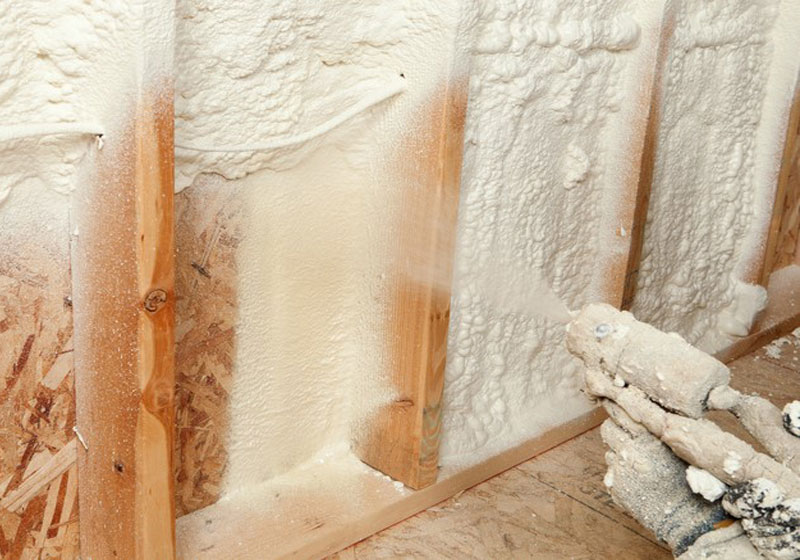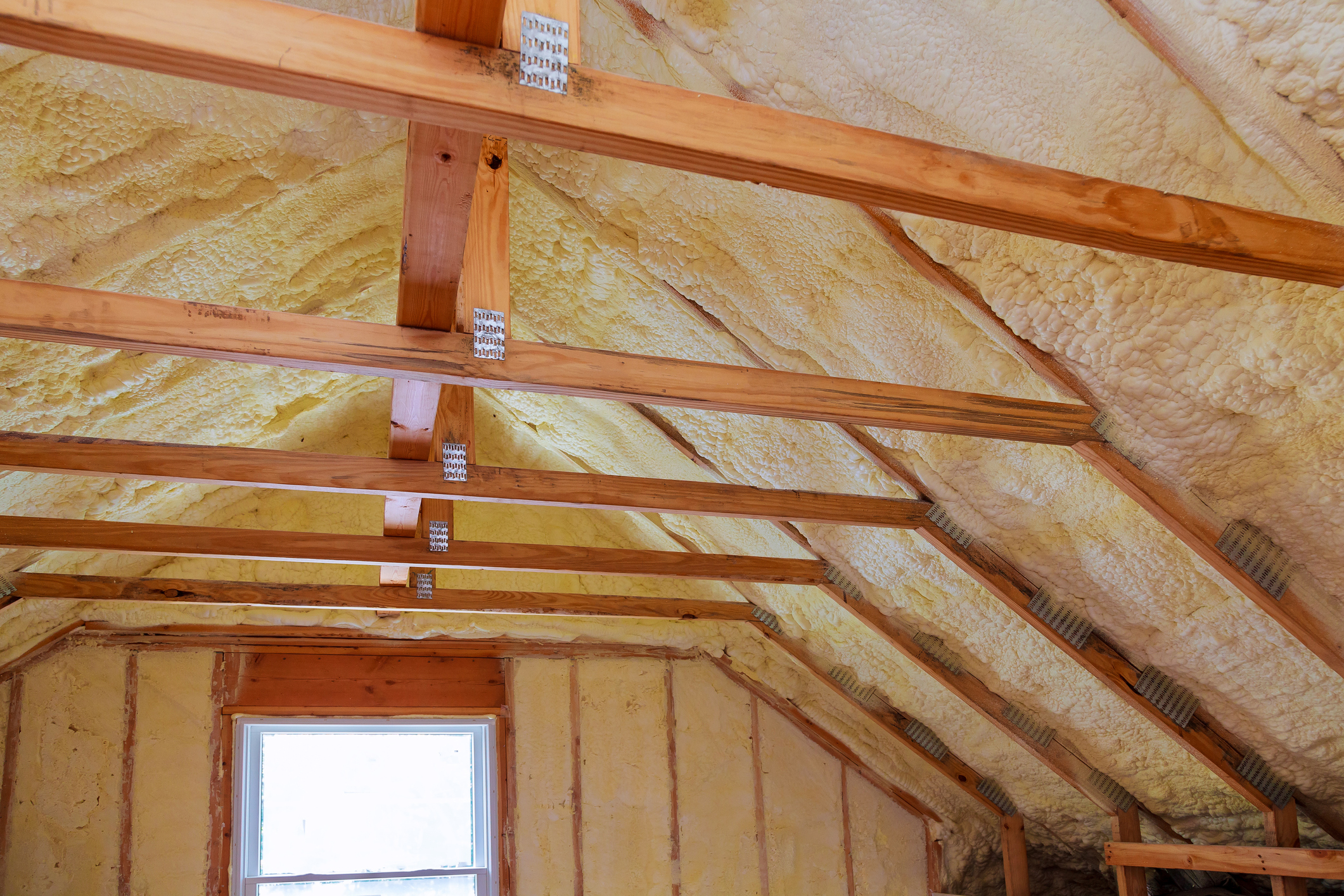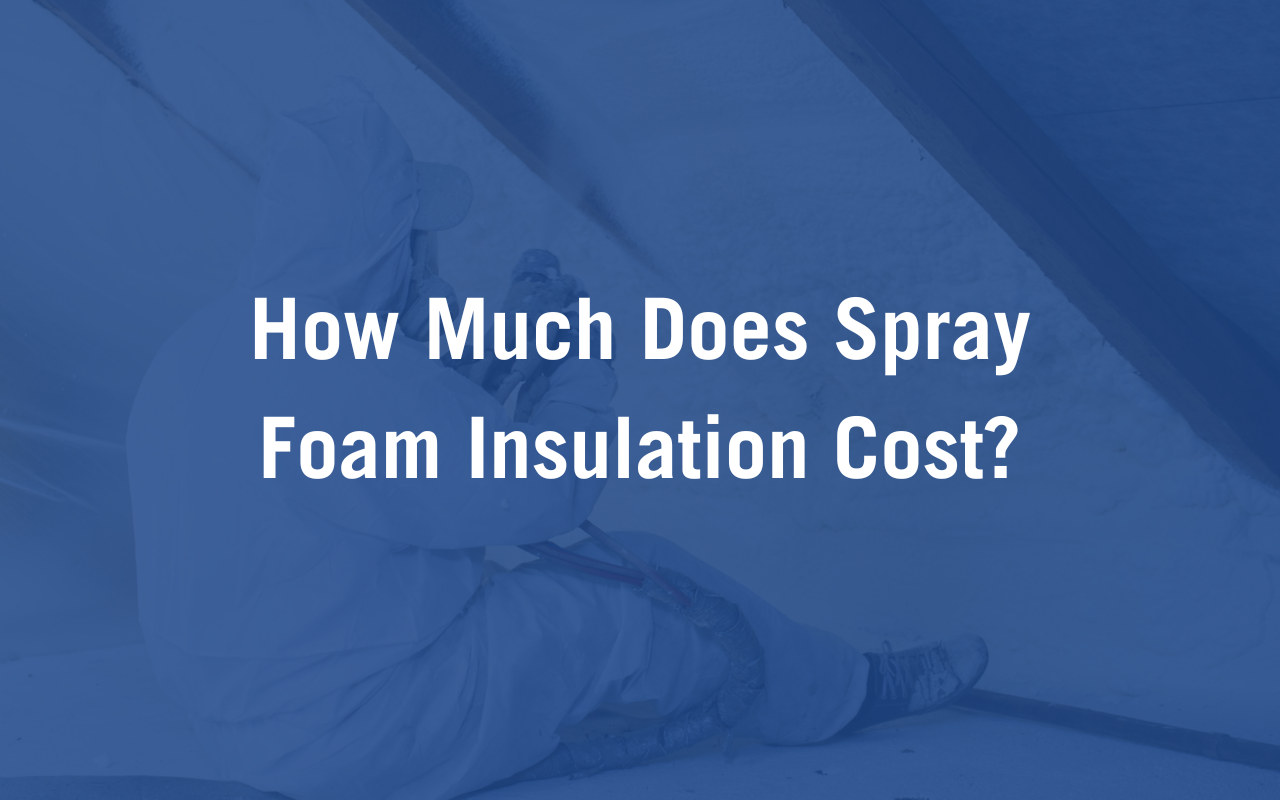Spray foam insulation is one of the most popular home insulation products, but it also can be among the priciest. You may be wondering – just how much does spray foam insulation cost?
The cost of spray foam insulation depends on the specific type of insulation you want, how thick it is, and how many square feet your home requires. Minnesota Exteriors can help you understand the cost of foam insulation and how we can protect your home.

What Is Spray Foam Insulation?
Before we delve more into spray foam insulation cost, it’s imperative to understand just what this type of insulation is. Workers apply spray foam insulation in a liquid form that expands and hardens to fill the space. Most commonly spray foam insulation is used in attics, basements, and behind walls.
Spray foam insulation is great at filling cracks and gaps in spaces, enhancing energy efficiency and durability by expanding to fit the exact space where it is needed. The energy savings and longevity of spray foam make it such a popular option, for traditional and modern homes alike.

Types of Spray Foam Insulation
The price for spray foam insulation also depends on its type: open-cell or closed-cell. Something called the r-value affects both, which basically measures the insulation’s resistance to external and internal sources of energy transfers. They each have unique characteristics:
- Open-Cell Spray Foam: Open-cell spray foam is a thinner layer of foam insulation with a weaker insulating power because of a lesser R-value (about 2-3.5 per inch). This type of foam insulation is best used in locations with a warmer climate.
- Closed-Cell Spray Foam: This is a denser and thicker form of insulation foam. Being harder, stronger, and more rigid in structure, this insulation prevents air and water vapors from escaping.
How Much Is Spray Foam Insulation?: Average Costs
The average cost of spray foam insulation often ranges anywhere from $0.45 – $1.70 per board foot, which measures out to 1 square foot by 1 inch thick. However, depending on the size of your space, what thickness of foam insulation you need, and other factors, this can drastically change.
Cost by Type of Insulation
The type of insulation will change how expensive your project is. Open-cell insulation is often more affordable because it requires fewer chemicals and less product to fill the same space. However, this makes it not as energy efficient or durable compared to closed-cell foam insulation cost.
Source: Architectural Digest
Cost by Thickness of Insulation
The thickness of insulation also affects the cost for spray foam insulation. The thicker the insulation, the higher the performance and durability, leading to a higher cost. Homeowners generally use thicker insulation to achieve specific R-values, which vary depending on the climate they live in.
Cost by Square Footage of Project
The size of the area you’re insulating will also change the cost of spray foam insulation per square foot. Larger projects will require more material, chemicals, and labor resulting in a bigger total investment for your home.
Understand everything from insulation to plumbing and what to expect from a home inspection.
Factors of Spray Foam Insulation Cost
Many factors go into answering the question of “How much does it cost for spray foam insulation?” However, beyond just the closed- and open-cell aspects of insulation, other aspects determine foam insulation price, such as:
Complexity of Area
While the size of an area will undoubtedly influence spray foam insulation price, it’s also important to consider the complexity of the area itself. Oddly shaped or hard-to-reach areas often require additional insulation time and even specialized equipment, leading to a higher overall cost.
Insulation Thickness and Required R-Value
The R-value of the insulation directly affects how expensive the project is. Depending on the climate, the R-value your home requires will vary, including:
- Warmer Climates: Warmer climates mean the insulation is installed to protect your house from the heat outside. Because of this, the R-value should be anywhere from R-30 to R-49.
- Moderate Climates: A moderate climate means the area is affected by both heat and cold. The foam needs to protect your home so that it doesn’t get too warm in the summer, and that you and your family don’t freeze in the winter. Therefore, the R-value needs to range from R-38 to R-60.
- Cold Climates: The battle in these climates is against winter chills and potential frostbite. Foam insulations in such environments need an R-value of R-49 to R-60.
New Construction vs. Existing Property
In most cases, it’s much easier – and cheaper – to insulate new construction projects, as there aren’t any existing structures or prior insulation to work around. For example, when insulating an oddly shaped attic that already has insulation, you will need the old insulation removed, and the space filled up strategically. This drives up the attic foam insulation cost.
Regional Pricing Variations
Various regional factors will affect spray foam insulation cost per square foot, such as:
- Climate
- Supply availability
- Local labor rates
Be sure to reach out to a reputable and skilled insulation company, like Minnesota Exteriors, to ensure you get the best price for your local climate and insulation needs.
Additional Costs: Removal, Repairs, and Permits
Additionally, there are extra costs that can increase how expensive spray foam cost per square foot is. While these will vary by the specific project complexity and where you live, some aspects to consider include:
- Possible insulation removal
- Repairs to your home or other structural needs
- Permit requirements

Benefits of Spray Foam Insulation
Spray foam offers multiple benefits compared to other insulation types, ensuring that homeowners and builders alike are satisfied with how well their home is protected. Some of the most notable benefits of foam insulation include:
Air Sealing and Moisture Blocking
With the way that spray foam expands and hardens, it is an ideal choice for creating an effective air seal that prevents drafts and moisture infiltration. This air-tight seal can also reduce the risk of mold and mildew growth.
Long Lasting and Durable
Spray foam insulation is also very durable compared to other insulation types, such as cellulose or fiberglass, often outlasting them by a few decades. Its longevity makes the fact that it has a higher up-front cost much cheaper overall.
Energy Saving For Lower Utility Bills
Spray foam insulation is also superior compared to other insulation types since it can also lower your home’s utility bills, resulting in longer-term energy savings. It safeguards your home from intense heat or cold, ensuring that you stay protected.
Soundproofing
Spray foam insulation can also contribute to soundproofing your home by absorbing sound waves and reducing noise transmission between rooms or from the outdoors. Spray foam insulation provides a valuable feature for homes located in high-traffic or noisy areas.
Added Structural Strength
Spray foam insulation – especially closed-cell spray foam – can add structural integrity to walls and ceilings, which offers additional strength and protection to the building. This can be especially beneficial for commercial buildings that utilize this insulation type.
Get an inspection from Minnesota Exteriors to determine the best approach for insulating your home or business.
Drawbacks of Spray Foam Insulation
While there are many benefits of this insulation type, it’s still important to weigh the pros and cons accurately so that you make an informed choice about what kind of insulation is best for your home or building. Some potential drawbacks of spray foam insulation to consider include the following:
Installation Complexity
Due to the complexity of spray foam, along with its technical and chemical nature, it requires professional application. Reach out to a reputable company to conduct the installation to ensure that there aren’t any safety or structural issues when the foam is applied.
Difficult and Costly Removal
Removing spray foam insulation can be challenging and expensive if any future renovations or repairs are needed. While spray insulation is still a superior choice in many other ways, it’s important to consider this aspect if you need future flexibility for your home.
Higher Initial Costs
As mentioned earlier, the long-term savings of spray foam insulation generally outweigh the upfront costs, but it’s still important to realize that this type of insulation will have a higher cost initially.

Spray Foam Insulation vs. Other Types of Insulation
There are other types of insulation you may also be researching for your home, including fiberglass, cellulose, and mineral wool. Compared to spray foam, these other insulation types don’t last nearly as long for your home. Generally, they only last for 20-60 years compared to spray foam’s 80-100 years.
Additionally, these insulation types aren’t as effective at providing energy efficiency or moisture blocking. However, fiberglass and cellulose insulation are often much cheaper and easier to install, meaning that if you need a fast fix, those options can be a great buffer until you get the added protection of spray foam.
Get a FREE Quote For Attic Insulation From Minnesota Exteriors
If you’re ready to safeguard your home for the long run, spray foam insulation can be just what you need. Not only will it ensure your home stays protected from the elements, but it can lead to greater cost-savings and longevity as well.
Reach out to our team at Minnesota Exteriors today for a free quote. We can provide more information about how we can protect either your residential or commercial building, guiding you through the insulation process with ease and clarity. Get in touch with the most trusted home improvement company in the Twin Cities today to learn more.
Spray Foam Insulation FAQ
How Much Does Spray Foam Insulation Cost Per Sq. Ft.?
On average, spray foam insulation costs anywhere from $.45 – $1.70 per board foot (1 board foot = 1 square foot by 1 inch thick).
How Do You Calculate Spray Foam Cost?
Your installation company will calculate spray foam cost by incorporating the R-value you’ll need, how large your space is, how thick you want your insulation to be, and whether you want open- or closed-celled insulation.
Is There A Downside to Spray Foam Insulation?
Some downsides to spray foam insulation include high upfront costs, difficulty and costly removal, and installation complexity.
When Should You Not Use Spray Foam Insulation?
You should not use spray foam insulation if you’re installing it near electrical wiring or fixtures, in damp areas, and well-ventilated areas, as spray foam might inhibit this ventilation.
Is Spray Foam Insulation Worth the Extra Cost?
Spray foam insulation is worth the extra upfront costs due to its energy efficiency, long-term cost savings, and durability it provides your home.



